It is only right to dedicate a blog post to the very things that inspired my username: comets! Comets are small objects that orbit the Sun and tend to have more eccentric orbits than other bodies in the solar system. A comet consists of a nucleus, coma, ion tail, and dust tail. The nucleus is solid and mostly composed of volatile ices, silicate, and organic dust particles. The coma is the bright and flowing atmosphere surrounding the nucleus that is caused when the comet gets near the Sun and its ices sublimate. The ion tail is typically blue due to the CO+ ions in it. It is created when solar wind sweeps away ionized volatile gases found in the coma; the volatile gases are ionized by ultraviolet photons coming from the Sun. The dust tail is made up of dust particles that are pushed backwards by solar radiation pressure, producing a tail that tends to be long, curved, and either yellow or white.
Additionally, comets are usually named after the people who discovered them. Sometimes, they are named after the individuals who first noticed that they had periodic orbits. A “C” before a comet’s name indicates that it has a long period while a “P” before a comet’s name indicates that it is periodic. A “D” before a comet’s name means that it is deceased or destroyed. These are just a few examples of the great detail that goes into naming a comet.














